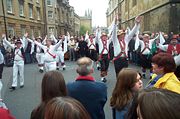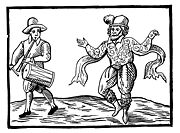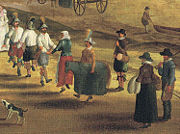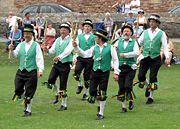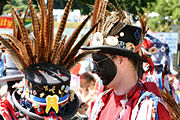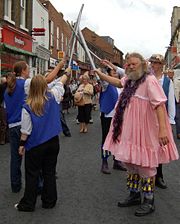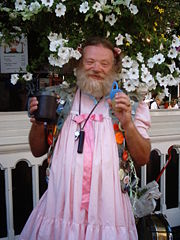Morris dance
2008/9 Schools Wikipedia Selection. Related subjects: Recreation
A morris dance is a form of English folk dance usually accompanied by music. It is based on rhythmic stepping and the execution of choreographed figures by a group of dancers. Implements such as sticks, swords, and handkerchiefs may also be wielded by the dancers. In a small number of dances for one or two men, steps are performed near and across a pair of clay tobacco pipes laid across each other on the floor.
There are claims that English records of the morris dance dating back to 1448 exist, but these are open to dispute. There is no mention of "morris" dancing earlier than the late 15th century, although early records such as Bishops' "Visitation Articles" mention sword dancing, guising and other dancing activities as well as mumming plays. Furthermore, the earliest records invariably mention "Morys" in a court setting, and both men and women are mentioned as dancing, and a little later in the Lord Mayors' Processions in London. It is only later that it begins to be mentioned as something performed in the parishes. There is certainly no evidence that it is a pre- Christian ritual, as is often claimed.
In the modern day, it is commonly thought of as a uniquely English activity, although there are around 150 morris sides (or teams) in the United States. British expatriates form a larger part of the morris tradition in Australia, Canada, New Zealand, and Hong Kong, and there are isolated groups in other countries, for example that in Utrecht, Netherlands, and Alsace, France.
Origins of the term
While there is still some dispute as to the origin of the term "morris," the most widely accepted theory is that the term was moorish dance, morisques in France, moriskentanz in Germany, moreška in Croatia, and moresco or morisca in Italy and Spain, which eventually became morris dance. Dances with similar names and some similar features are mentioned in Renaissance documents in France, Italy, Germany, Croatia, and Spain, throughout, in fact Catholic Europe. This is hardly surprising; by 1492 Ferdinand of Aragon and Isabella of Castille succeeded in driving the Moors out of Spain and unifying the country. In celebration of this a pageant known as a Moresca was devised and performed. This can still be seen performed in places such as Ainsa, Aragon. Incorporated into this pageant was the local dance - the Paloteao. This too can still be seen performed in the villages of Aragon. The similarity to what became known as the English "morris" is undoubted. Early court records state that the "moresque" was performed at court in her honour, including the dance - the "moresque" or "morisce" or "morys" dance.
History in England
Before the English Civil War, the working peasantry took part in morris dances, especially at Whitsun. In 1600 the Shakespearean actor William Kempe morris danced from London to Norwich, an event chronicled in his Nine Days Wonder (1600). The Puritan government of Oliver Cromwell, however, suppressed Whitsun Ales and other such festivities. When the crown was restored by Charles II, the springtime festivals were restored. In particular, Whitsun Ales came to be celebrated on Whitsunday, as the date coincided with the birthday of Charles II.
Morris dancing continued in popularity until the industrial revolution and its accompanying social changes. Four teams claim a continuous lineage of tradition within their village or town: Abingdon (their morris team was kept going by the Hemmings Family), Bampton, Headington Quarry, and Chipping Campden. Other villages have revived their own traditions, and hundreds of other teams across the globe have adopted (and adapted) these traditions, or have created their own styles from the basic building blocks of morris stepping and figures.
Several English folklorists were responsible for recording and reviving the tradition in the early 20th century, often from a bare handful of surviving members of mid-19th-century village sides. Among these, the most notable are Cecil Sharp, Maud Karpeles, and Mary Neal. Boxing Day 1899 is widely regarded as the starting point for the morris revival. Cecil Sharp was visiting at a friend's house in Headington, near Oxford, when the Headington Quarry morris side arrived to perform. Sharp was intrigued by the music and collected several tunes from the side's musician, William Kimber; not until about a decade later, however, did he begin collecting the dances, spurred and at first assisted by Mary Neal, a founder of the Espérance Club (a dressmaking cooperative and club for young working women in London), and Herbert MacIlwaine, musical director of the Esperance Club. Neal was looking for dances for her girls to perform, and so the first revival performance was by young women in London.
In the first few decades of the 20th century, several men's sides were formed, and in 1934 the Morris Ring was founded by six revival sides. In the 1960s and especially the 1970s, there was an explosion of new dance teams, some of them women's or mixed sides. At the time, there was often heated debate over the propriety and even legitimacy of women dancing the morris, even though there is evidence as far back as the 16th century that there were female morris dancers. There are now male, female and mixed sides to be found.
Partly because women's and mixed sides are not eligible for full membership of the Morris Ring, two other national (and international) bodies were formed, the Morris Federation and Open Morris. All three bodies provide communication, advice, insurance, instructionals (teaching sessions) and social and dancing opportunities to their members. The three bodies cooperate on some issues, while maintaining their distinct identities.
Styles
Today, there are six predominant styles of morris dancing, and different dances or traditions within each style named after their region of origin.
- Cotswold morris: dances from an area mostly in Gloucestershire and Oxfordshire; an established misnomer, since the Cotswolds overlap this region only partially. Normally danced with handkerchiefs or sticks to accompany the hand movements.
- North West morris: more military in style and often processional. Clogs are a characteristic feature of this style of dance.
- Border Morris from the English-Welsh border: a simpler, looser, more vigorous style, normally danced with blackened faces (or sometimes otherwise coloured, given the negative connotations for some of blackface).
- Longsword dancing from Yorkshire and south Durham.
- Rapper or Short sword dancing from Northumberland and Co. Durham.
- Molly Dancing from East Anglia.
Cotswold
Lionel Bacon records Cotswold morris traditions from these villages: Abingdon, Adderbury, Ascot-under-Wychwood, Badby, Bampton, Bidford, Bledington, Brackley, Bucknell, Chipping Campden, Ducklington, Eynsham, Headington Quarry, Hinton-in-the-Hedges, Ilmington, Kirtlington, Leafield, Longborough, Oddington, Sherbourne, Stanton Harcourt, and Wheatley.
Bacon also lists the tradition from Lichfield, which is Cotswold-like despite that city's distance from the Cotswold morris area; the authenticity of this tradition has been questioned. In 2006 a small number of dances from a previously-unknown tradition was discovered by Barry Care of Moulton Morris Men (Ravensthorpe, Northants) - two of them danceable.
Other dances listed by Bacon include border morris dances from Brimfield, Bromsberrow Heath, Evesham, Leominster, Much Wenlock, Pershore, Upton-upon-Severn, Upton Snodsbury, White Ladies Aston, and miscellaneous non-Cotswold, non-Border dances from Steeple Claydon and Winster. There are a number of traditions which have been invented since the mid twentieth century, though few have been widely adopted. Examples are Broadwood, Duns Tew, and Ousington-under-Wash in the Cotswold style, and Upper and Lower Penn in the Border style. In fact, for many of the "collected" traditions in Bacon, only sketchy information is available about the way they were danced in the nineteenth century, and they have been reconstructed to a degree that makes them largely twentieth century inventions as well. Some traditions have been reconstructed in several strikingly disparate ways; an example would be Adderbury, danced very differently by the Adderbury Morris Men and the Adderbury Village Morris.
North West
The North West tradition is very different, and has always featured mixed and female sides - at least as far back as the eighteenth century. There is a picture of Eccles Wakes (painted in the 1820s, judging by the style of dress of some of the participants and spectators) that shows both male and female dancers.
The dancers originally wore clogs and were often associated with rushcarts at the local wakes or holidays. The dances themselves were often called 'maze' or 'garland dances' as they involved a very intricate set of movements in which the dances wove in and out of each other. Some dances were performed with a wicker hoop (decorated with garlands of flowers) held above the dancer's head. Some dancers were also associated with a tradition of mumming, holding a pace egging play in their area.
The Britannia Coco-nut Dancers, named after a mill not far from Bacup, are unique in the tradition, in that they used sawn bobbins to make a noise, and perform to the accompaniment of a brass ensemble. They are one of the few North West morris groups that still black up their faces. It is said that the dance found its way to the area through Cornishmen who migrated to work in the Rossendale quarries.
Towards the end of the nineteenth century, the Lancashire tradition was taken up by sides associated with mills and nonconformist chapels, usually composed of young girls. These lasted until the First World War, after which many mutated into 'jazz dancers.' (A Bolton troupe can be seen in a pre-war documentary by Humphrey Jennings) They later evolved into 'pom pom' dancers (still called 'morris dancers' by older people). During the folk revival in the 1960s, many of the old steps to dances such as 'Stubbins Lane Garland' were often passed on by old people.
Border
The term "border morris" was first used by E. C. Cawte in a 1963 article on the morris dance traditions of Herefordshire, Shropshire, and Worcestershire — counties along the border with Wales. Characteristics of the tradition as practiced in the nineteenth and early twentieth centuries include blackface (in some areas); use of either a small strip of bells (in some areas) or no bells at all (in others); costume often consisting of ordinary clothes decorated with ribbons, strips of cloth, or pieces of coloured paper; or sometimes "fancy dress"; small numbers of dances in the team repertoire, often only one and rarely more than two; highly variable number of dancers in the set and configurations of the set (some sides had different versions of a dance for different numbers of dancers); and an emphasis on stick dances almost to the exclusion of hankie dances. Dances tended to be uncomplicated in form, e.g. alternation of sticking with a hey; stepping was likewise not elaborate. While performances at various times of the year are recorded, the most common dancing occasion was Boxing Day. Border morris performance persisted into the early twentieth century before it died out.
Many dances were collected, by Cecil Sharp and later collectors, and several were included in Bacon's book, but border morris was largely neglected by revival morris sides until late in the twentieth century. The Silurian Morris Men of Ledbury, Herefordshire changed over from Cotswold to Border morris in 1979, and the Shropshire Bedlams were founded in 1975; both became pioneers of a resurgence of border morris among revival sides in the following decades. Silurian has emphasized re-creation of the traditional border dances, while the Shropshire Bedlams have created a new repertoire of what some call "neo-border" dances, tending to be more complex and theatrical than the collected dances.
Sword dancing
Usually regarded as a type of morris, although many of the performers themselves consider it as a traditional dance form in its own right, is the sword dance tradition, which includes both rapper sword and longsword traditions. In both styles the "swords" are not actual swords, but implements specifically made for the dance. The dancers are usually linked one to another via the swords, with one end of each held by one dancer and the other end by another. Rapper sides usually consist of five dancers, who are permanently linked-up during the dance. The rapper sword is a very flexible strip of spring-steel, with a fixed handle at one end, and a rotating handle at the other. The longsword is about 0.8 metres long, with a wooden handle at one end, a rounded tip, and no edge. Longsword sides consist usually of either six or eight dancers. In both rapper and longsword there is often with a supernumerary, who dances around, outside, and inside the set.
Mumming
The English mummers play occasionally involves morris or sword dances either incorporated as part of the play or performed at the same event. Mummers plays are often performed in the streets near Christmas to celebrate the New Year and the coming springtime. In has central themes of death and rebirth.
Other traditions
Other forms include Molly dance from Cambridgeshire. Molly dance, which is associated with Plough Monday, is a parodic form danced in work boots and with at least one Molly man dressed as a woman. The largest Molly Dance event is the Whittlesea Straw Bear Festival, established in 1980, held at Whittlesey in Cambridgeshire in January.
There is also hoodening which comes from East Kent, and the Abbots Bromley Horn Dance.
Another expression of the morris tradition is Vessel Cupping. This was practised in the East Riding of Yorkshire until the 1920s. It was a form danced by itinerant ploughboys in sets of three or four, about the time of Candlemas.
Music
Music was traditionally provided by either a pipe and tabor or a fiddle. These are still used today, but the most common instrument is the melodeon. Accordions and concertinas are also common, and other instruments are sometimes used. Often drums are employed.
Cotswold and sword dancers are most often accompanied by a single player, but Northwest and Border sides often have a band, usually including a drum.
For Cotswold and (to a degree) Border dances, the tunes are traditional and specific: the name of the dance is often actually the name of the tune, and dances of the same name from different traditions will have slightly different tunes. For Northwest and sword dancing there is less often a specific tune for a dance: the players may use several tunes, and will often change tunes during a dance.
Several notable albums have been released, in particular the Morris On series, which consists of Son of Morris On, Grandson of Morris On, Great Grandson of Morris On, and Morris On The Road.
Terminology
Like many activities, morris dancing has a range of words and phrases that it uses in special ways.
Many participants will refer to the world of morris dancing as a whole as the morris.
A morris troupe is usually referred to as a side or a team. The two terms are interchangeable. Despite the terminology, morris dancing is hardly ever competitive.
A set (which can also be referred to as a side) is a number of dancers in a particular arrangement for a dance. Most Cotswold morris dances are danced in a rectangular set of six dancers, and most Northwest dances in a rectangular set of eight; but there are many exceptions.
A jig is a dance performed by one (or sometimes two) dancers, rather than by a set. Its music does not usually have the rhythm implied by the word jig in other contexts.
The titles of officers will vary from side to side, but most sides have at least the following:
- The role of the squire varies. In some sides the squire is the leader, who will speak for the side in public, usually lead or call the dances, and often decide the programme for a performance. In other sides the squire is more of an administrator, with the foreman taking the lead, and the dances called by any experienced dancer.
- The foreman teaches and trains the dancers, and is responsible for the style and standard of the side's dancing.
- The bagman is traditionally the keeper of the bag — that is to say, the side's funds. In some sides today the bagman acts as secretary (particularly bookings secretary) and there is often a separate treasurer.
- On some sides a ragman manages and co-ordinates the team's kit or costume. This may include making bell-pads, ribbon bads, sashes and other accoutrements.
Many sides have one or more fools. A fool will usually be extravagantly dressed, and communicate directly with the audience in speech or mime. The fool will often dance around and even through a dance without appearing really to be a part of it, but it takes a talented dancer to pull off such fooling while actually adding to and not distracting from the main dance set.
Many sides also have a beast: a dancer in a costume made to look like a real or mythical animal. Beasts mainly interact with the audience, particularly children. In some groups this dancer is called the hobby.
Most Cotswold dances alternate common figures (or just figures) with a distinctive figure (or chorus). The common figures are common to all (or some) dances in the tradition; the distinctive figure distinguishes that dance from others in the same tradition. Sometimes (particularly in corner dances) the choruses are not identical, but have their own sequence specific to the tradition. Nevertheless, something about the way the chorus is danced will distinguish that dance from others. Several traditions will often have essentially the same dance, where the name, tune, and distinctive figure are the same or similar, but each tradition employs its common figures and style.
In England, an ale is a private party where a number of morris sides get together and perform dances for their own enjoyment rather than for an audience. Food is usually supplied, and sometimes this is a formal meal known as a feast or ale-feast. Occasionally an evening ale will be combined with a day or weekend of dance, where all the invited sides will tour the area and perform in public. In North America the term is widely used to describe a full weekend of dancing involving public performances and sometimes workshops. In the sixteenth to nineteenth centuries, the term "ale" referred to a church- or village-sponsored event where ale or beer was sold to raise funds. Morris dancers were often employed at such events.
Evolution of the morris
The "soul" of morris dancing exists within the many individual sides, which are for the most part constituted as clubs, each with its own constitution and procedures. These clubs act in a general harmony of good-will, each acknowledging the geographic rights of others. While there is nothing to stop one side performing in the heartland of another, this is rarely done without permission and agreement.
The continuance of the morris is as much in the hands of independent groups of enthusiasts as it is in the nationwide groupings such as the Morris Ring. So while for some sides there is a feeling that the music and dance recorded in the 19th century should be maintained, there are others who freely reinterpret the music and dance to suit their abilities.
The sides, however, do not exist in isolation. Instead they will meet regularly, not just at Ring Meetings, but also at the annual Feast that many sides organise. Apart from copious amounts of drinking and eating, the Feast (which can run over two days) is also an occasion for large numbers of morris dancers and musicians from across the country to come together in massed ensembles, performing throughout the area covered by the host side.
Most morris clubs now have their own website (www.morrismen.org.uk is a typical example) recording their exploits and listing their forthcoming performances.
Spelling
"Morris" is sometimes capitalized, though in this context it is not a proper noun.
Namesakes
The dance may have given name to the board games three men's morris, six men's morris and nine men's morris.
Erasmus Grasser, a German sculptor, created 16 realistic animated wood figures in the late 15th century called the morris dancers.
British satirist and novelist Terry Pratchett features morris dancing in a number of his works, most notably " Lords and Ladies" and " Wintersmith": including the famed dark morris.
New Zealand author Ngaio Marsh's novel Off With His Head (1957) is a detective story based around a morris dance.
